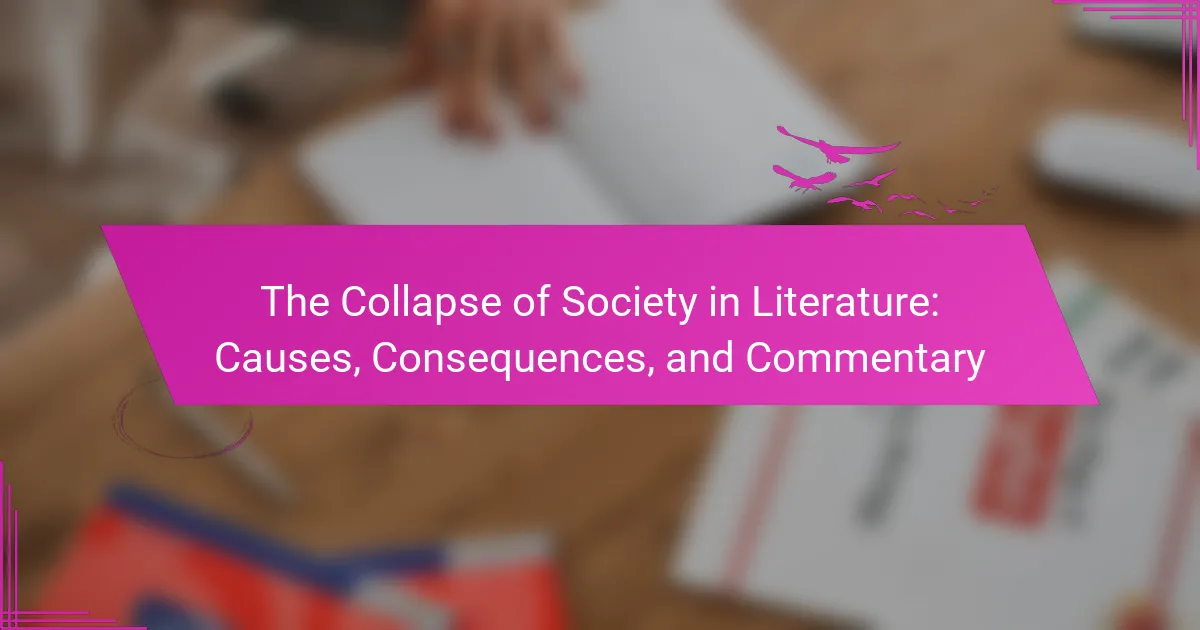Literature often reflects societal collapse, revealing the underlying causes such as political corruption, environmental degradation, and economic inequality. The consequences include chaos, moral decay, and the breakdown of social order. Different cultures portray these themes uniquely, offering valuable commentary on human behaviour and resilience. Notable examples illustrate both the decline and the potential for recovery in the face of adversity.
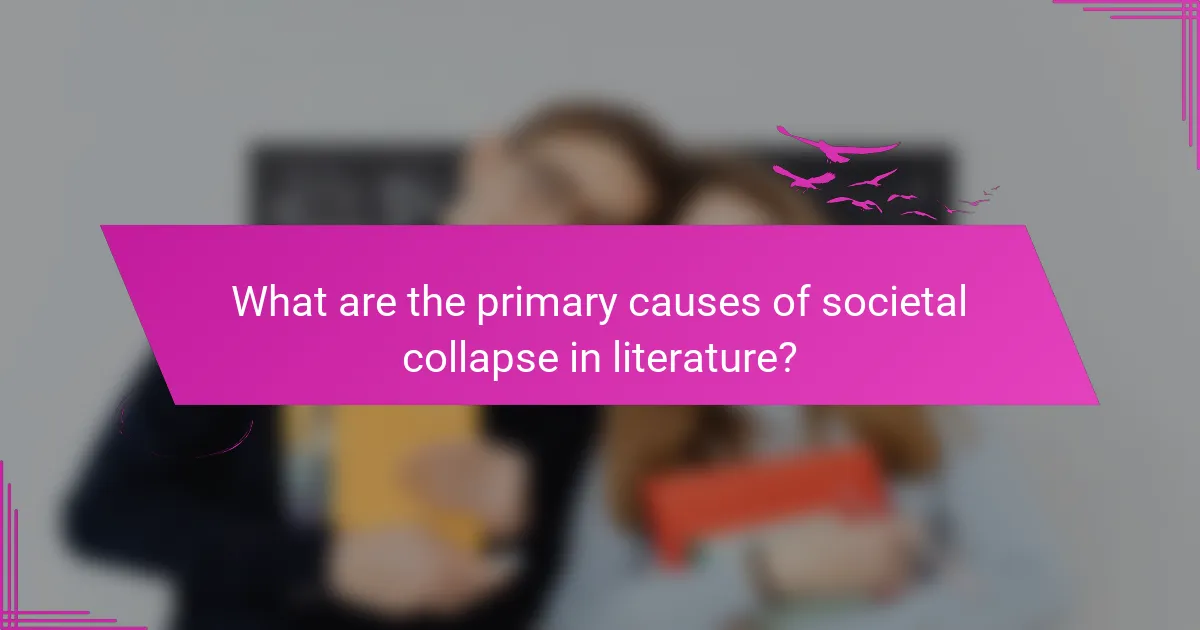
What are the primary causes of societal collapse in literature?
Societal collapse in literature often stems from political corruption, environmental degradation, economic inequality, and social disintegration. These causes highlight human vulnerabilities and systemic failures. Political corruption leads to loss of trust, while environmental degradation threatens survival. Economic inequality fosters unrest, and social disintegration erodes community bonds. Each factor contributes to a narrative of decline and serves as a cautionary tale about contemporary issues.
How do historical contexts influence depictions of collapse?
Historical contexts significantly shape depictions of societal collapse in literature. Authors often reflect contemporary fears, political climates, and cultural anxieties. For example, post-war literature frequently portrays dystopian societies, mirroring societal disillusionment. The Great Depression influenced works depicting economic collapse, highlighting human resilience. In contrast, modern narratives may focus on environmental degradation, showcasing climate change concerns. These contexts enrich themes of power, survival, and morality, making them relevant to readers’ experiences.
Which psychological factors contribute to societal disintegration?
Psychological factors contributing to societal disintegration include fear, distrust, and disillusionment. Fear of instability leads to anxiety and social withdrawal. Distrust in institutions erodes community bonds, while disillusionment with societal values fosters apathy. These elements create a cycle of disengagement, weakening social cohesion and collective identity.
What role do environmental disasters play in literature about collapse?
Environmental disasters serve as pivotal catalysts in literature about societal collapse, illustrating the fragility of civilization. They often embody themes of loss, resilience, and the consequences of human neglect toward nature. For instance, novels like “The Road” by Cormac McCarthy depict a post-apocalyptic world shaped by environmental ruin, emphasizing the dire outcomes of ecological mismanagement. These narratives reflect societal fears and critiques of contemporary environmental policies, urging readers to confront the potential realities of climate change and resource depletion. By incorporating such disasters, authors enhance the urgency of their commentary on human vulnerability and the interconnectedness of society and the environment.
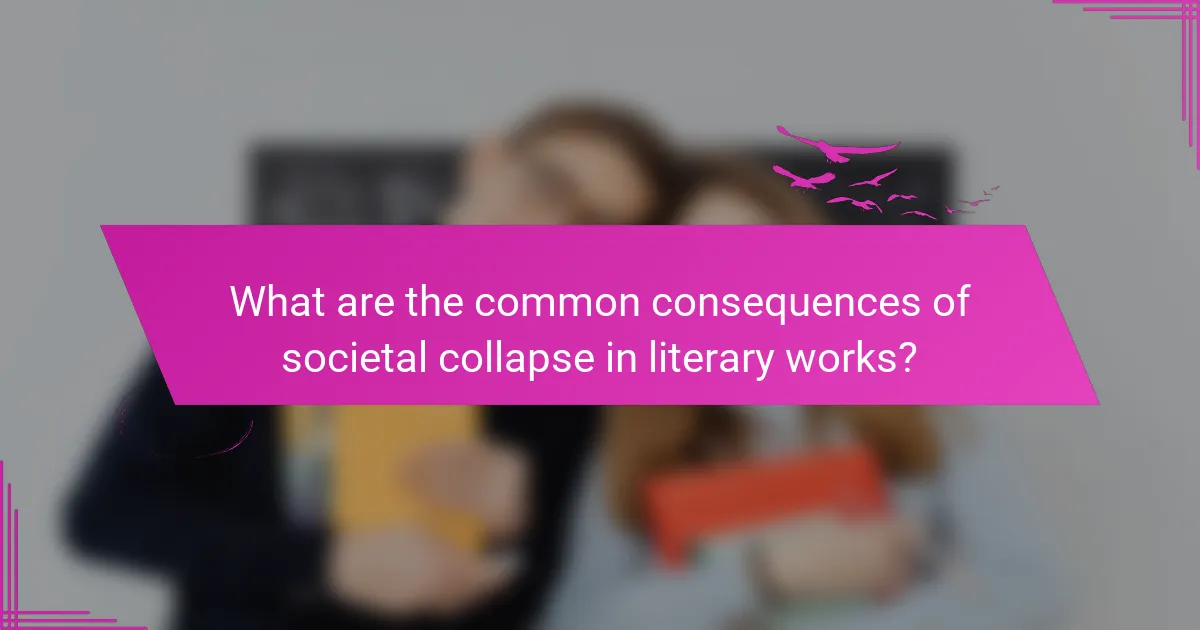
What are the common consequences of societal collapse in literary works?
Common consequences of societal collapse in literary works include widespread chaos, loss of social order, and moral decay. Characters often face survival challenges, leading to conflict and distrust. Themes of isolation and despair frequently emerge, reflecting the psychological impact on individuals. Additionally, literature often explores the breakdown of institutions and the re-emergence of primitive behaviours, illustrating humanity’s struggle in dire circumstances.
How do characters respond to societal breakdown in literature?
Characters in literature often respond to societal breakdown with a mix of resilience and despair. Their actions reflect the consequences of chaos, showcasing survival instincts and moral dilemmas. For example, in Cormac McCarthy’s “The Road,” the father and son navigate a post-apocalyptic world, emphasizing the struggle for hope amidst devastation.
Responses vary widely, from embracing anarchy to seeking community. In William Golding’s “Lord of the Flies,” characters descend into savagery, highlighting the fragility of civilization. Conversely, in dystopian works like “The Handmaid’s Tale” by Margaret Atwood, characters resist oppression, showcasing the human spirit’s fight against societal collapse.
Ultimately, these literary portrayals serve as commentaries on human nature, questioning the balance between order and chaos. Such narratives reflect unique attributes of characters, revealing their depths in extreme circumstances.
What themes emerge from the aftermath of collapse in narratives?
Themes that emerge from the aftermath of societal collapse in literature include resilience, moral ambiguity, and the critique of civilization. Resilience often highlights human perseverance despite adversity. Moral ambiguity questions ethical boundaries in survival situations. Critique of civilization reflects on societal flaws that lead to collapse. These themes explore the complexities of human nature and societal structures.
Which societal structures are most often critiqued post-collapse?
Post-collapse, societal structures such as government, economic systems, and social hierarchies are frequently critiqued. These critiques often focus on their failures to maintain stability and address the needs of the populace.
Governments are criticized for their inability to provide security and order, leading to chaos. Economic systems face scrutiny for exacerbating inequality, which contributes to societal breakdown. Social hierarchies are examined for perpetuating division and conflict, hindering collective recovery efforts.
Literature often reflects these critiques, illustrating the consequences of systemic failures. For example, dystopian narratives highlight the fragility of governance and the impact of economic disparity on human relationships.
These themes underscore the need for reevaluating societal structures to prevent future collapses. The analysis of these critiques serves as a cautionary tale, encouraging reflection on the resilience of social systems.

How does the portrayal of collapse differ across cultures in literature?
The portrayal of collapse varies significantly across cultures in literature, reflecting unique societal fears and values. In Western literature, themes often focus on individualism and technological failure, as seen in works like “The Road” by Cormac McCarthy. In contrast, Eastern literature may emphasize communal loss and moral decline, as illustrated in “The Tale of Genji” by Murasaki Shikibu. Cultural context shapes these narratives, influencing how collapse is depicted and understood. For instance, post-apocalyptic scenarios in American literature frequently explore survivalism, while African literature may highlight the impact of colonialism and social fragmentation. Each cultural lens provides a distinct commentary on the human condition amid societal breakdown.
What unique attributes define dystopian narratives in different regions?
Unique attributes defining dystopian narratives vary by region and reflect cultural concerns. In Western literature, themes often include government surveillance and individualism, illustrating fears of authoritarianism. In Eastern narratives, collectivism and environmental degradation emerge as prominent issues, highlighting societal harmony versus chaos. African dystopias frequently address colonial legacies and economic instability, emphasizing resilience and community. Latin American works often explore political corruption and social inequality, focusing on the struggles of marginalized groups. Each region’s unique attributes shape its dystopian commentary, revealing distinct societal anxieties and aspirations.
How do cultural values shape the interpretation of societal collapse?
Cultural values significantly influence how societies interpret collapse. Different cultures prioritize varying aspects like community, individualism, or spirituality, shaping their narratives around societal decline. For instance, collectivist societies may emphasize the loss of community bonds, while individualistic cultures might focus on personal failures. This leads to diverse interpretations in literature, reflecting unique societal concerns and moral lessons. As a result, cultural values not only inform the causes of collapse but also the consequences and responses depicted in literary works.
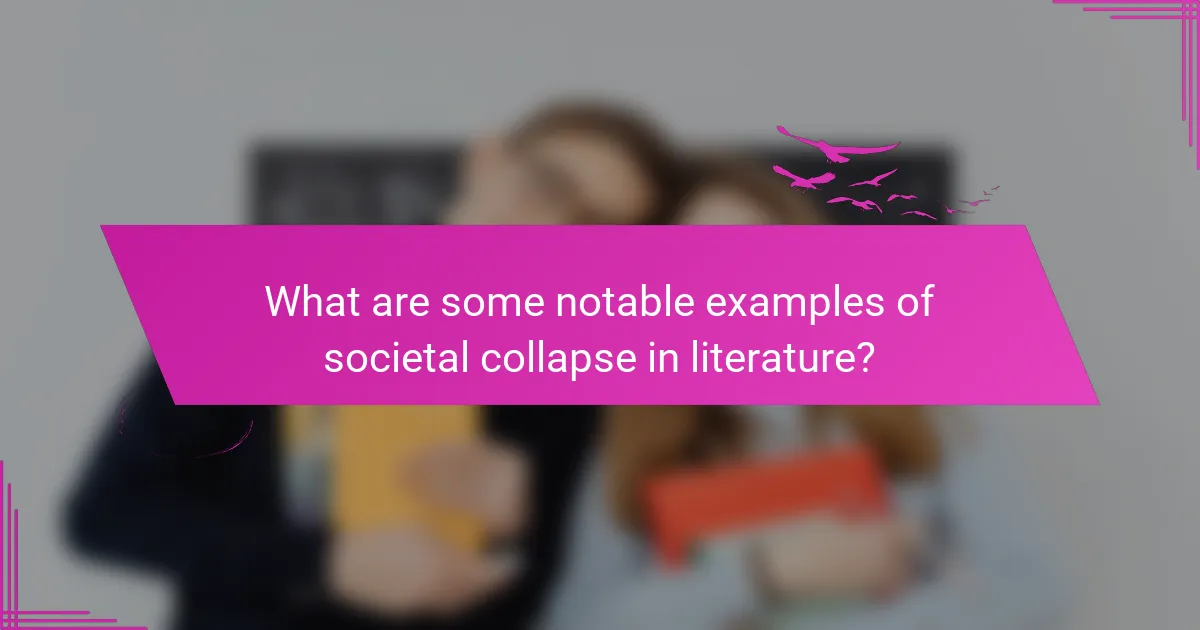
What are some notable examples of societal collapse in literature?
Notable examples of societal collapse in literature include “The Road” by Cormac McCarthy, depicting a post-apocalyptic world. “Lord of the Flies” by William Golding explores the descent into savagery among stranded boys. “1984” by George Orwell illustrates a totalitarian regime’s impact on society. “The Handmaid’s Tale” by Margaret Atwood presents a dystopian future where women’s rights are stripped away. “Station Eleven” by Emily St. John Mandel examines life after a pandemic. These works reflect various causes and consequences of societal breakdown, offering commentary on human nature and civilization.
Which classic novels best illustrate the theme of collapse?
Classic novels that illustrate the theme of collapse include “1984,” “Lord of the Flies,” and “The Road.” These works depict societal breakdown through totalitarianism, loss of civilization, and post-apocalyptic scenarios.
“1984” by George Orwell showcases a dystopian society where oppressive government control leads to the collapse of individual freedoms. “Lord of the Flies” by William Golding explores the descent into savagery among stranded boys, revealing the fragility of civilization. “The Road” by Cormac McCarthy presents a bleak vision of a world devastated by an unspecified catastrophe, emphasizing survival amidst societal ruin.
These novels provide commentary on human nature and the factors that contribute to societal collapse, such as power dynamics, moral decay, and environmental disasters. Their narratives resonate with contemporary issues, prompting reflection on the resilience and vulnerability of societies.
How have contemporary authors reimagined the concept of societal breakdown?
Contemporary authors have reimagined societal breakdown by exploring diverse causes and consequences through unique narratives. They depict themes of environmental collapse, technological dystopias, and political disintegration. For example, novels like “The Road” by Cormac McCarthy illustrate survival amid desolation, highlighting human resilience. Additionally, authors such as Octavia Butler in “Parable of the Sower” comment on social inequality and climate change, presenting a future shaped by current issues. This reimagining fosters critical discourse on contemporary challenges, urging readers to reflect on the fragility of society.
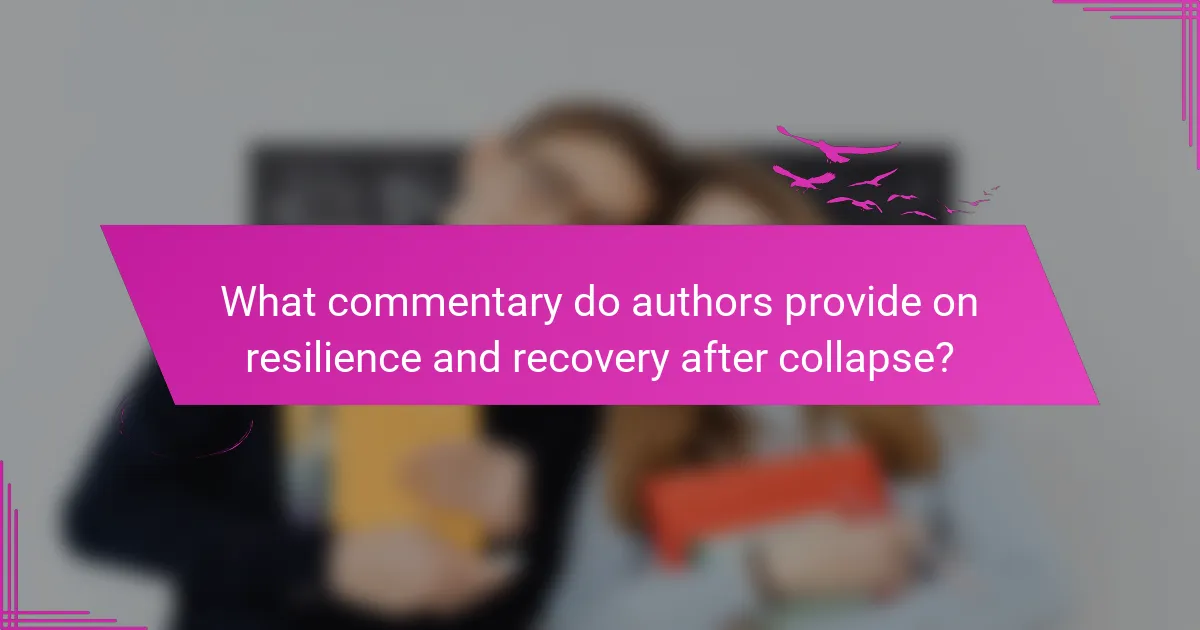
What commentary do authors provide on resilience and recovery after collapse?
Authors frequently highlight resilience and recovery as vital themes following societal collapse. They explore how individuals and communities adapt to new realities, emphasizing the strength found in human connections and shared experiences.
In literature, resilience often manifests through characters who confront adversity and emerge transformed. For example, in post-apocalyptic narratives, protagonists frequently demonstrate resourcefulness and determination, illustrating the human capacity to rebuild.
Recovery is portrayed as a gradual process, requiring both personal and collective efforts. Authors depict the importance of hope and vision for a better future, suggesting that while collapse brings suffering, it can also inspire innovation and growth.
Ultimately, commentary on resilience and recovery emphasizes the enduring human spirit, showcasing how societies can learn from past failures to forge stronger foundations for the future.
How do narratives of hope emerge in the face of societal failure?
Narratives of hope emerge in the face of societal failure by showcasing resilience and the human spirit’s capacity for renewal. Literature often reflects this through characters who confront adversity, emphasizing themes of community, love, and perseverance. These narratives serve as a counterbalance to despair, illustrating how individuals can find purpose and strength amid chaos. For instance, dystopian novels frequently depict protagonists who inspire change, fostering optimism despite bleak circumstances. Such stories resonate deeply, encouraging readers to envision a better future and motivating collective action.
What lessons can be drawn from literature about rebuilding society?
Literature teaches that rebuilding society requires understanding the causes of collapse, fostering community resilience, and embracing adaptability. Works like “The Road” by Cormac McCarthy highlight the importance of hope and cooperation in dire circumstances. Additionally, dystopian narratives often emphasize the need for ethical leadership and social equity as foundational elements for recovery. These lessons underscore that a strong moral compass and collective effort are essential for societal reconstruction.
Which literary techniques are used to convey messages of resilience?
Literary techniques such as symbolism, imagery, and characterization effectively convey messages of resilience. Symbolism often represents hope or strength, while imagery creates vivid scenes of struggle and perseverance. Characterization allows readers to connect with resilient individuals facing societal collapse, emphasizing their determination and adaptability. These techniques deepen the narrative, illustrating the human spirit’s power to endure adversity.

What practical insights can be gained from studying societal collapse in literature?
Studying societal collapse in literature provides insights into human behaviour, resilience, and the consequences of systemic failures. These narratives often illustrate root causes such as environmental degradation, political corruption, and social inequality. They serve as cautionary tales, highlighting the fragility of civilization and the importance of community and cooperation in overcoming crises. Furthermore, literature reflects unique cultural perspectives on collapse, revealing diverse responses and adaptations to adversity. Ultimately, these stories encourage critical thinking about current societal issues and inspire proactive solutions.
How can readers apply lessons from literary collapses to real-world scenarios?
Readers can apply lessons from literary collapses by recognizing patterns of societal failure and resilience. Literature often reflects the consequences of moral decay, environmental neglect, and social injustice. By analyzing these themes, readers can identify similar issues in contemporary society. For example, dystopian narratives highlight the dangers of authoritarianism and the erosion of civil liberties, prompting critical reflection on current governance. Additionally, understanding the psychological impacts of collapse in literature can foster empathy and proactive engagement in real-world issues. This awareness encourages individuals to advocate for change and cultivate community resilience against potential societal breakdowns.
What are common mistakes to avoid when interpreting themes of collapse?
Common mistakes to avoid when interpreting themes of collapse include oversimplifying causes, ignoring character perspectives, and neglecting historical context. Analyzing literature on societal collapse requires a nuanced understanding of complex interactions and consequences. Failing to recognize the multifaceted nature of collapse can lead to misinterpretations and shallow readings. Additionally, overlooking the emotional and psychological impacts on characters can diminish the depth of the narrative.
Which best practices enhance understanding of societal dynamics in literature?
Best practices for enhancing understanding of societal dynamics in literature include analyzing character motivations, exploring themes of power and conflict, and examining historical contexts. These elements provide insights into the causes and consequences of societal collapse, enriching commentary on the narrative. Additionally, utilizing diverse perspectives fosters a comprehensive view of societal interactions, revealing unique attributes within the text. Engaging with reader interpretations can further illuminate rare attributes, encouraging deeper discussions around societal dynamics.
